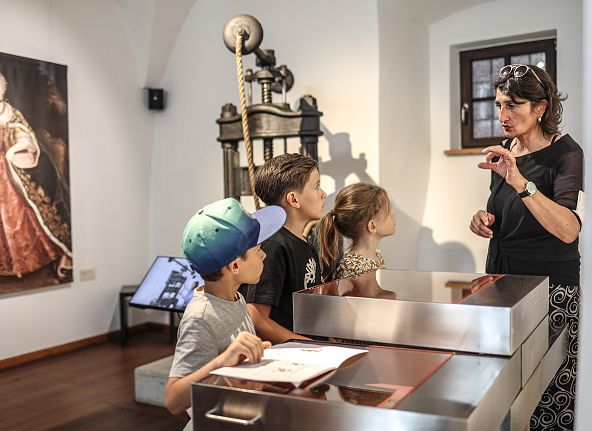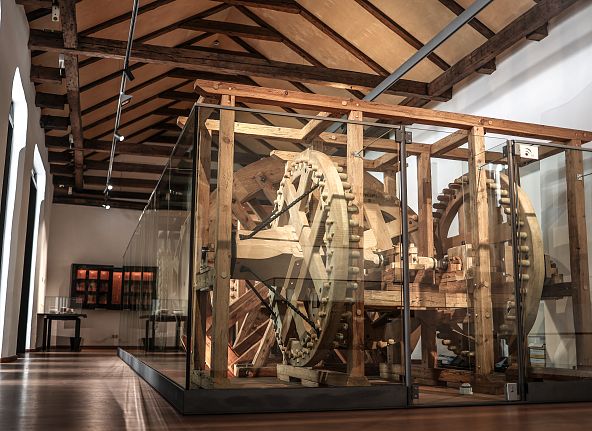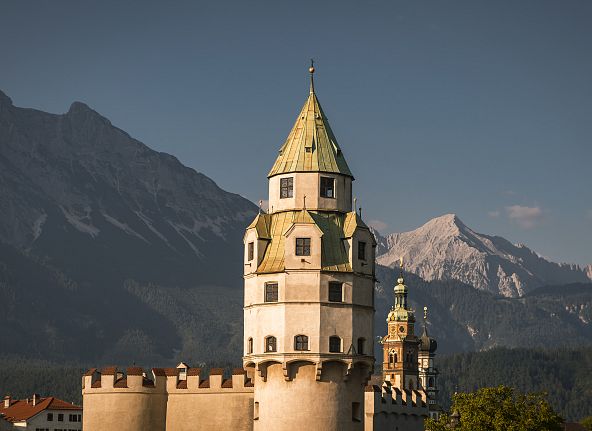The European Thaler. Hall Mint
On the occasion of the 2008 European Football Championships and the 500th anniversary of the first European Emperor Maximilian I, the Hall Mint, in cooperation with the Austrian Mint, is producing the world's largest silver thaler with 2008 dag, as well as 2008 pieces of the European thaler in a limited edition.
This is a replica of the imperial taler from 1508 with the inscription referring to Europe. The reverse makes reference to the 2008 European Football Championship and the historical development of Europe. The design of the reverse of the coin comes from the think tank of the Austrian Mint under the direction of Thomas Pesendorfer, who is also regarded as the inventor of the Vienna Philharmonic.
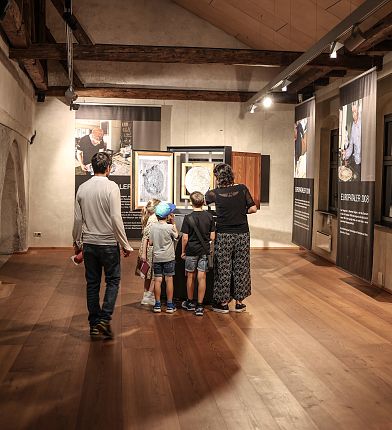
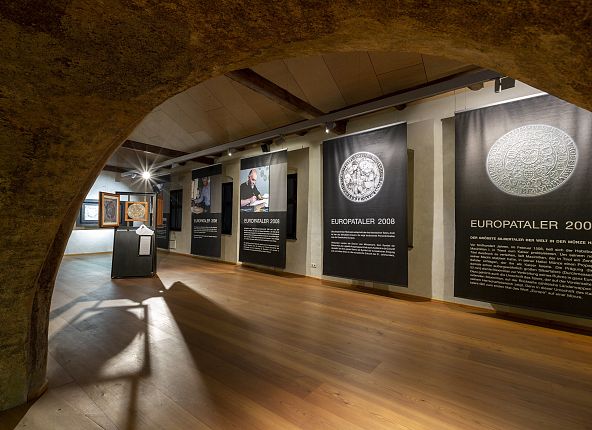
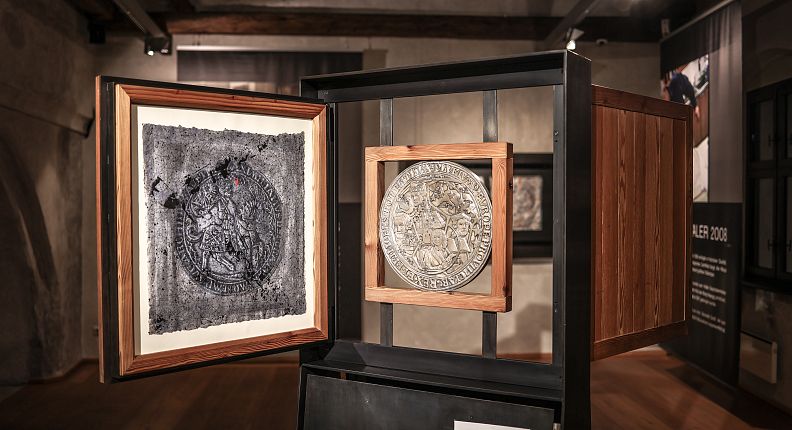
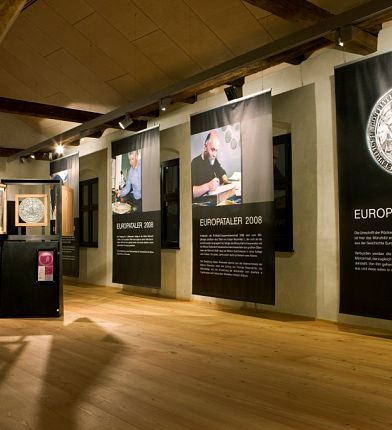
The coin design and the realization of the coin images were created by the medalist Herbert Wähner, who is also very well known in specialist circles. The packaging of the "silver giants" is produced by master wood turner Werner Nuding from Hall using 500-year-old wood from Hasegg Castle, which was salvaged during renovation work in 2007.
The internationally renowned artist Ernst Friedrich from Hall and his wife Eleonor were commissioned to design the packaging.
History of the Europataler
An emperor as a starting point: In February 1508, the Habsburg Maximilian I had himself proclaimed emperor in Trento. He was unable to reach his actual destination, the city of Rome, as the Venetians blocked his path. However, they were unable to prevent Maximilian's elevation to the most powerful man in Europe. To express his new title, Maximilian, who had established a center of power in Tyrol, had a propaganda thaler struck at his mint in Hall, celebrating him as emperor.
The minting of this silver thaler, which was already unusually large at the time (diameter approx. 60 mm), served Maximilian to spread his fame throughout Europe. This also included the coin's inscription, which shows Maximilian on horseback on the obverse and numerous national coats of arms from his reign on the reverse.
The inscription reads: MAXIMILIANVS DEI GRA(tia) ROM(anorum) IMP(erator) SEMP(er) AVG(vstvs) ARCHIDVX AVSTRIE / PLVRIVMQ(ve) EVROPE PROVINCIAR(vm) REX ET PRINCEPS POTENTISIM(vs).
In other words: Maximilian, by the grace of God Emperor of the Romans, all-time ruler of the empire, Archduke of Austria / King of numerous European countries and most powerful prince. This is the first time the word "Europe" appears on a coin.
Harmony of opposites - down to the last detail
As a storage and presentation object, the "presentation casket" is intended to set different accents through the contrast between art and nature, the main object itself, through action and interaction. Wood, as a raw material that has grown alive in nature, demands a treatment of contrasts. Former "wooden beams" from false ceilings in historic rooms are transformed into presentation artworks using wood from Hasegg Castle that is over 500 years old.
The presentation caskets are crafted by master wood turner Werner Nuding from Hall, who is also responsible for the replica of the first and only roller embossing machine in the world.
Numismatic data
- Edition: 2008 pieces
- Fineness: Ag 999
- Coin design: RV Herbert Wähner / MÖ
- Fine weight: 120 g
- Diameter: 60 mm
- Quality: patinated and lacquered
The front of the Europataler
The obverse of the thaler corresponds to that from the time of Maximilian in 1508, showing the newly crowned emperor in armor on horseback; in his hand he holds a banner with the imperial symbol, the double-headed eagle.
The obverse of the thaler corresponds to that from the time of Maximilian in 1508, showing the newly crowned emperor in armor on horseback; in his hand he holds a banner with the imperial symbol, the double-headed eagle.
The back of the Europataler
The inscription on the reverse corresponds to that of the historical taler, but the image on the coin has been renewed.
The reverse shows important personalities from the history of Europe.
It begins with Martin Luther, who symbolizes the transition from the Middle Ages to modern times with his posting of theses and his translation of the Bible in the 16th century. The Reformation and Counter-Reformation that followed this event have had a lasting impact on the religious and intellectual history of Europe to this day.
The work of Antonio Vivaldi is exemplary of the importance of European cultural life. The red-haired priest from Venice is one of the greatest European composers of the 17th century.
The industrialization of Europe, which took place as a result of major technical innovations in the Age of Enlightenment, brought lasting changes. These inventions include, in particular, the construction of the first steam engine by James Watt in the 18th century.
The great upheavals in Europe also include the constant attempts to civilize the numerous wars on the continent and replace them with a pacifist policy. Even though this goal was far from being achieved, the Nobel Peace Prize winner Bertha von Suttner was one of the first exponents of this development in the 19th century.
However, lasting peace and economic progress were only achieved in Europe after the catastrophes of the two world wars in the second half of the 20th century. The process of European unification proved to be one of the most sustainable means of securing lasting peace.
These scenes are linked by the Mint Tower, the symbol of the Hall Mint, which represents both a starting point and a view into the future: Stars emanate from it as a symbol of European unification, leading into the European future of the 21st century.
Maximilian year 2019
The 500th anniversary of the death of Emperor Maximilian I was celebrated in Tyrol in 2019 - with many events and cultural highlights. In addition to an exhibition entitled "Maximilian I - The Coins of a Media Emperor" at the Hall Mint, there were guided tours, hikes and a historical festival to mark the occasion.
